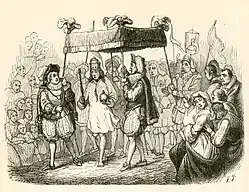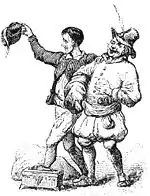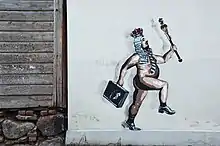The Emperor's New Clothes
"The Emperor's New Clothes" (Danish: Kejserens nye klæder [ˈkʰɑjsɐns ˈnyˀə ˈkʰleːɐ̯]) is a literary folktale written by Danish author Hans Christian Andersen, about a vain emperor who gets exposed before his subjects. The tale has been translated into over 100 languages.[1]
| "The Emperor's New Clothes" | |||
|---|---|---|---|
| Short story by Hans Christian Andersen | |||
 Illustration by Vilhelm Pedersen, Andersen's first illustrator | |||
| Original title | Kejserens nye klæder | ||
| Country | Denmark | ||
| Language | Danish | ||
| Genre(s) | Literary folktale | ||
| Publication | |||
| Published in | Fairy Tales Told for Children. First Collection. Third Booklet. 1837. (Eventyr, fortalte for Børn. Første Samling. Tredie Hefte. 1837.) | ||
| Publication type | Fairy tale collection | ||
| Publisher | C.A. Reitzel | ||
| Publication date | 7 April 1837 | ||
| Chronology | |||
| |||
"The Emperor's New Clothes" was first published with "The Little Mermaid" in Copenhagen, Denmark, by C. A. Reitzel, on 7 April 1837, as the third and final installment of Andersen's Fairy Tales Told for Children. The tale has been adapted to various media, and the story's title, the phrase "the Emperor has no clothes", and variations thereof have been adopted for use in numerous other works and as idioms.
.png.webp)
Plot
Two swindlers arrive at the capital city of an emperor who spends lavishly on clothing at the expense of state matters. Posing as weavers, they offer to supply him with magnificent clothes that are invisible to those who are stupid or incompetent. The emperor hires them, and they set up looms and go to work. A succession of officials, and then the emperor himself, visit them to check their progress. Each sees that the looms are empty but pretends otherwise to avoid being thought a fool.
Finally, the weavers report that the emperor's suit is finished. They mime dressing him and he sets off in a procession before the whole city. The townsfolk uncomfortably go along with the pretense, not wanting to appear inept or stupid, until a child blurts out that the emperor is wearing nothing at all. The people then realize that everyone has been fooled. Although startled, the emperor continues the procession, walking more proudly than ever.
Sources
Andersen's tale is based on a 1335 story from the Libro de los ejemplos (or El Conde Lucanor),[2] a medieval Spanish collection of fifty-one cautionary tales with various sources such as Aesop and other classical writers and Persian folktales, by Juan Manuel, Prince of Villena (1282–1348). Andersen did not know the Spanish original but read the tale in a German translation titled "So ist der Lauf der Welt" ("That's the way of the world").[3] In the source tale, a king is hoodwinked by weavers who claim to make a suit of clothes invisible to any man not the son of his presumed father; whereas Andersen altered the source tale to direct the focus on courtly pride and intellectual vanity rather than adulterous paternity.[4][5]
There is also an Indian version of the story, which appears in the Līlāvatīsāra by Jinaratna (1283), a summary of a now-lost anthology of fables, the Nirvāṇalīlāvatī by Jineśvara (1052). The dishonest merchant Dhana from Hastināpura swindles the king of Śrāvastī by offering to weave a supernatural garment that cannot be seen or touched by any person of illegitimate birth. When the king is supposedly wearing the garment, his whole court pretends to admire it. The king is then paraded about his city to show off the garment; when the common folk ask him if he has become a naked ascetic, he realizes the deception, but the swindler has already fled.[6]
Commentaries
Hollis Robbins, in "The Emperor's New Critique" (2003), argues that the tale is itself so transparent "that there has been little need for critical scrutiny".[7] Robbins argues that Andersen's tale "quite clearly rehearses four contemporary controversies: the institution of a meritocratic civil service, the valuation of labor, the expansion of democratic power, and the appraisal of art".[8] Robbins concludes that the story's appeal lies in its "seductive resolution" of the conflict by the truth-telling boy.
Naomi Wood of Kansas State University challenges Robbins' reading, arguing that before the World Trade Center attacks of 2001, "Robbins's argument might seem merely playful, anti-intuitive, and provocative."[9] Wood concludes: "Perhaps the truth of 'The Emperor's New Clothes' is not that the child's truth is mercifully free of adult corruption, but that it recognizes the terrifying possibility that whatever words we may use to clothe our fears, the fabric cannot protect us from them."[10]
In 2017, Robbins returned to the tale to suggest that the courtiers who pretend not to see what they see are models of men in a workplace who claim not to see harassment.[11]
Adaptations and cultural references



Various adaptations of the tale have appeared since its first publication.
Film and television
1919 Russian short film directed by Yuri Zhelyabuzhsky
In 1953, theatrical short titled The Emperor's New Clothes, produced by UPA.
In 1961, Croatian feature film The Emperor's New Clothes directed by Ante Babaja, writer Božidar Violić (see IMDB).[12]
In the 1965 Doctor Who serial The Romans, the Doctor uses the story as inspiration to avoid his disguise as a lyre player being discovered. He later claims to have given Andersen the original idea for the story in the first place.
In 1970, Patrick Wymark appeared as the Emperor in Hans Christian Andersen, an Australian musical and comedy television special highlighting three of Andersen's most famous stories. It was broadcast five weeks after Wymark's untimely death in Melbourne.[13]
In 1972, Rankin/Bass Productions adapted the tale as the first and only musical episode of ABC series The Enchanted World of Danny Kaye, featuring Danny Kaye, Cyril Ritchard, Imogene Coca, Allen Swift, and Bob McFadden. The television special features eight songs with music by Maury Laws and lyrics by Jules Bass, and combines live action filmed in Aarhus, Denmark, animation, special effects, and the stop motion animation process "Animagic" made in Japan.
In 1985, Shelley Duvall's Faerie Tale Theatre adapted the fairy tale, starring Dick Shawn as the Emperor while Alan Arkin and Art Carney starred as the con artists.
The 1987, Japanese war documentary film The Emperor's Naked Army Marches On, by director Kazuo Hara, centers on 62-year-old Kenzō Okuzaki, veteran of Japan's Second World War campaign in New Guinea, and follows him around as he searches out those responsible for the unexplained deaths of two soldiers in his old unit.
The Emperor's New Clothes, a 1987 musical comedy adaptation of the fairy tale starring Sid Caesar, part of the Cannon Movie Tales. series[1]
The Emperor's New Clothes (1991) animated film, by Burbank Animation Studios.
Muppet Classic Theater has an adaptation of the story with Fozzie as the emperor, and with Rizzo and two of his fellow rats as the swindlers.
In the 1997 television drama ...First Do No Harm, Lori (played by Meryl Streep) is shown reading this story to her young son Robbie (played by Seth Adkins).
Despite the phrasing of the title, the 2000 film The Emperor's New Groove by Walt Disney Animation Studios is not related to Andersen’s classic tale, although both stories involve an emperor being tricked.
An original video animation (OVA) episode of the anime franchise Bikini Warriors humorously adapts the tale, wherein the main characters are stripped nude by an unseen deity under the pretense that it has actually gifted them with a new, legendary bikini armor that only "idiots" are unable to see.[14]
HBO Family aired an animated adaptation called The Emperor’s Newest Clothes in 2018. Alan Alda narrated the tale and Jeff Daniels was the voice of the Emperor.[15]
Other media
On 1 March 1957, Bing Crosby recorded a musical adaptation of the story for children which was issued as an album Never Be Afraid by Golden Records in 1957.[16]
In 1968, on their Four Fairy Tales and Other Children's Stories album, the Pickwick Players performed a version of this story that is actually a version of "The King's New Clothes" from the film Hans Christian Andersen. In this version, two swindlers trick the Emperor into buying a nonexistent suit, only for a boy to reveal the truth in the end. There are several differences from the original Danny Kaye version, most importantly a new verse ("This suit of clothes put all together is altogether / The most remarkable suit of clothes, that you've already said. The shirt is white, the cape is ermine, the hose are blue,/ And the doublet is a lovely shade of red!"[17] To which the emperor replies "Green! Glorious Green!" and the Court asks "How could we think it was red!"
In 1980, computer scientist C. A. R. Hoare used a parody tale, The Emperor's Old Clothes, to advocate simplification over embellishment, for clothing or computer programming languages.[18]
In 1985, Jack Herer published the first edition of The Emperor Wears No Clothes, which uncovers the history of industrial hemp through civilization, culminating in a propaganda campaign in the U.S. in the early 20th century. The book is now in its 11th edition.
In 1989, Roger Penrose parodied artificial intelligence as having no substance in his book The Emperor's New Mind.[19]
Elton John uses the title of the story in the opening track of his 2001 album Songs from the West Coast.
Irish singer Sinéad O'Connor included a song called "The Emperor's New Clothes" on her 1990 album I Do Not Want What I Haven't Got, which references failed relationships.
In 2011, Tony Namate, an award-winning Zimbabwean cartoonist, published a collection of political cartoons entitled The Emperor's New Clods.[20] This collection features cartoons published in Zimbabwean newspapers between 1998 and 2005, highlighting some landmark moments in a troubled period of the country's history.
In 2014, the online game Final Fantasy XIV introduced[21] a gear set prefixed The Emperor's New, which is composed of gear pieces (e.g. The Emperor's New Gloves[22]) that do not have an in-game model, effectively displaying a character in underwear when the whole set is equipped. This followed requests from the player base to be able to hide a piece of equipment they do not want displayed, using the in-game glamour system that allows gear appearance alteration. The flavour text of the gear pieces is a tongue-in-cheek reference to the tale: "The most beautiful handwear you never have seen".
In 2016, Panic! At the Disco released a song titled "Emperor's New Clothes", which includes the lyrics "I'm taking back the crown. I'm all dressed up and naked."
In 2016, heavy metal act Megadeth released "The Emperor" on their 15th studio album, Dystopia, which won a Grammy.
In 2019, Radiohead´s leaked and then self-released MiniDiscs (Hacked) featured an incomplete song by the name "My New Clothes", in which the lyrics "The people stop and stare at the emperor" and "And even if it hurts to walk, and people laugh, I know who I am" were included.
In 2020, FINNEAS released a song titled "Where the Poison is", featuring the lyrics: "I guess not everybody knows the emperor was never wearin' any clothes." The song is presented as a criticism of Donald Trump and his administration's handling of the COVID-19 pandemic in the United States.[23]
Also in 2020, the expansion Greymoor for the MMORPG The Elder Scrolls Online included an altered version of the tale titled as "The Jarl's New Robes" in one of the books the player can read.
Use as an idiom
As an idiom, use of the story's title refers to something widely accepted as true or professed as being praiseworthy, due to an unwillingness of the general population to criticize it or be seen as going against popular opinion.[24] The phrase "emperor's new clothes" has become an idiom about logical fallacies.[25][26] The story may be explained by pluralistic ignorance.[27] The story is about a situation where "no one believes, but everyone believes that everyone else believes. Or alternatively, everyone is ignorant to whether the emperor has clothes on or not, but believes that everyone else is not ignorant."[28]
See also
References
- Andersen 2005a 4
- In Spanish:Exemplo XXXIIº – De lo que contesció a un rey con los burladores que fizieron el paño. In English: Of that which happened to a King and three Impostors from Count Lucanor; of the Fifty Pleasant Stories of Patronio, written by the Prince Don Juan Manuel and first translated into English by James York, M. D., 1868, Gibbings & Company, Limited; London; 1899; pp. xiii–xvi. Accessed 6 March 2010. This version of the tale is one of those collected by Idries Shah in World Tales.
- Bredsdorff p. 312–3
- Wullschlager 2000, p. 176
- Count Lucanor by Don Juan Manuel as Inspiration for Hans Christian Andersen and Other European Writers. HC Andersen Centret.
- Anthony Kennedy Warder (1992). Indian Kāvya Literature: The art of storytelling, Volume 6. pp. 261–262, 268–270.cited pages from Indian Kavaya Literature vol 6. 5 September 1992.
- Robbins, Hollis (Autumn 2003). "The Emperor's New Critique". New Literary History. 34 (4): 659–675. doi:10.1353/nlh.2004.0010. S2CID 170513535. Retrieved 1 March 2013.
- Robbins, Hollis (Autumn 2003). "The Emperor's New Critique". New Literary History. 34 (4): 670. Retrieved 1 March 2013.
- Wood p. 193–207
- Wood p. 205
- Robbins, Hollis (20 December 2017). "The Emperor's New Clothes and Workplace Harassment". Medium. Retrieved 1 January 2020.
- "Carevo novo ruho" – via www.imdb.com.
- "Hans Christian Andersen". IMDb.
- Bikini Warriors episode 15: これが伝説の防具を手に入れた勇者たちの姿である (lit.: "This is the Appearance of the Warriors who obtained the Legendary Armor"); 7 December 2016.
- Milligan, Mercedes (31 October 2018). "HBO Unbuttons 'The Emperor's Newest Clothes' Special Nov. 15". Animation Magazine. Retrieved 1 January 2020.
- "A Bing Crosby Discography". BING magazine. International Club Crosby. Retrieved 4 October 2017.
- Four Fairy Stories and Other Children's Stories, record album, 1968
- Hoare, C.A.R. (February 1981). "1980 Turing Award Lecture". Communications of the ACM. 24 (2): 75–83. doi:10.1145/358549.358561.
- Penrose, Roger; Lord Adrian (6 March 1991), "The Emperor's New Mind", RSA Journal, 139 (5420): 506–514, JSTOR 41378098
- Chipato, Michael (29 July 2011). "Namate cartoons in new book". www.newzimbabwe.com. Retrieved 4 July 2016.
- SQUARE ENIX Inc. "Patch 2.4 Notes (Full Release) | FINAL FANTASY XIV, The Lodestone". FINAL FANTASY XIV, The Lodestone. Retrieved 23 March 2017.
- SQUARE ENIX Ltd. "Eorzea Database: The Emperor's New Gloves | FINAL FANTASY XIV, The Lodestone". FINAL FANTASY XIV, The Lodestone. Retrieved 23 March 2017.
- Kreps, Daniel (8 November 2020). "Finneas Marks Trump's 'Firing' With New Song 'Where the Poison Is'". Rolling Stone.
- "Idoioms". TheFreeDictionary.com.
- Graves, Joseph L. (2003). The Emperor's New Clothes: Biological Theories of Race at the Millennium. Rutgers University Press. p. 1. ISBN 9780813533025.
- Robbins, Hollis (Autumn 2003). "The Emperor's New Critique". New Literary History. 34 (4): 659–675. doi:10.1353/nlh.2004.0010. S2CID 170513535. Retrieved 1 March 2013.
- Zellner, William W.; Petrowsky, Marc (1998). Sects, Cults, and Spiritual Communities: A Sociological Analysis. Bloomsbury Academic. p. 13. ISBN 9780275963354.
Like the villagers in the story of the emperor's new clothes, members of the inner circle were unwilling to reveal their ignorance by challenging .... As a result, they suppressed whatever doubts they had an worked even harder to make sense of what, in the final analysis, may have been nonsensical.
- Hansen, Jens Ulrik (2011). "A Logic-Based Approach to Pluralistic Ignorance". Academia.edu. Retrieved 1 March 2013.
Bibliography
- Adams, A.I. (2013). New Emperors' Novel Clothes - Climate Change Analysed. Connor Court Publishing Pty, Limited, 2013. ISBN 978-1922168801.
- Andersen, Hans Christian (2008). The Annotated Hans Christian Andersen. Translated by Allen, Julie K. Tatar, Maria (ed. and transl.). New York and London: W. W. Norton & Company, Inc. ISBN 978-0-393-06081-2.
- Andersen, Hans Christian (2005). Wullschlager, Jackie (ed.). Fairy Tales. Translated by Nunnally, Tiina. New York: Viking. ISBN 0-670-03377-4.
- Andersen, Hans Christian (2005). The Stories of Hans Christian Andersen: A New Translation from the Danish. Frank, Diane Crone; Frank, Jeffrey (eds. and transl.). Durham and London: Duke University Press. ISBN 0-8223-3693-6.
- Andersen, Jens (2005). Hans Christian Andersen: A New Life. Translated by Nunnally, Tiina. New York, Woodstock, London: Overlook Duckworth. ISBN 1-58567-737-X.
- Bredsdorff, Elias (1975). Hans Christian Andersen: The Story of His Life and Work, 1805–75. London: Phaidon Press Ltd. ISBN 0-7148-1636-1.
- Prince, Alison (1998). Hans Christian Andersen: The Fan Dancer. London: Allison & Busby Ltd. ISBN 0-7490-0478-9.
- Robbins, Hollis (Autumn 2003). "Emperor's New Critique". New Literary History. 34 (4): 659–675. doi:10.1353/nlh.2004.0010. ISSN 0028-6087. S2CID 170513535.
- Wood, Naomi (2007). "The Ugly Duckling's Legacy: Adulteration, Contemporary Fantasy, and the Dark". Marvels & Tales. 20 (2): 193–207. doi:10.1353/mat.2007.0019. S2CID 162325195.
- Wullschlager, Jackie (2000). Hans Christian Andersen: The Life of a Storyteller. Chicago: University of Chicago Press. ISBN 0-226-91747-9.
- Zipes, Jack David (2005). Hans Christian Andersen: The Misunderstood Storyteller. New York and Middleton Park: Routledge. ISBN 0-415-97433-X.
External links
- "Keiserens nye Klæder". Original Danish text
- "Keiserens nye Klæder". Manuscript from the Odense City Museum
- "The Emperor's New Clothes". English translation by Jean Hersholt
- "The Emperor's New Clothes". Audio rendition by Sir Michael Redgrave
 The Emperor's New Clothes public domain audiobook at LibriVox
The Emperor's New Clothes public domain audiobook at LibriVox